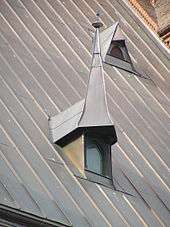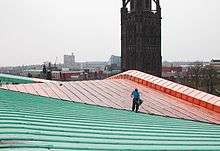Metal roof
A metal roof is a roofing system made from metal pieces or tiles characterized by its high resistance, impermeability and longevity. It is a component of the building envelope. Zinc, copper and steel alloys are commonly used.

History
Copper has played a significant role in architecture for thousands of years (see: copper in architecture). In the 3rd century B.C., copper roof shingles were installed atop the Lovamahapaya Temple in Sri Lanka.[1] The Romans used copper as roof covering for the Pantheon in 27 B.C.[2] Centuries later, copper and its alloys were integral in European medieval architecture. The copper roof of St. Mary's Cathedral, Hildesheim, installed in 1280 A.D., survived until its destruction during bombings in World War II.[3] The roof at Kronborg, one of northern Europe's most important Renaissance castles (immortalized as Elsinore Castle in Shakespeare’s Hamlet) was installed in 1585 A.D.[4] The copper on the tower was renovated in 2009.[5]
Advantages
Metal roofs can last up to 100 years, with installers providing 50 year warranties.[6] Because of their longevity, most metal roofs are less expensive than asphalt shingles in the long term.[7]
Metal roofing can consist of a high percentage of recycled material and is 100% recyclable.[8] It does not get as hot as asphalt, a common roofing material, and it reflects heat away from the building underneath in summertime. On a larger scale, its use reduces the heat island effect of cities when compared to asphalt. Coupled with its better insulating abilities, metal roofs can offer not only a 40% reduction in energy costs in the summer, but also up to a 15% reduction in the energy costs in the winter according to a 2008 Study by Oak Ridge National Laboratory. This finding is based on the use of a strapping system of four inches between the plywood and "cool-color" metal on top,[9] which provides an air gap between the plywood roof sheathing and the metal. Cool-color metals are light, reflective colors, like white. The study went on to say that re-sealing and insulating air ducts in the attic will save even more money.[10]
Metal roofing is also lightweight, creates little stress on the load bearing roof support structures and can be installed on top of an existing roof. A lightweight roof is very useful for large and or old structures, as it helps to maintain the overall structural integrity of the building.[11] Despite its light weight, metal roofing provides increased wind resistance when compared to other roofing materials. This is because metal roofing systems use interlocking panels.[12]
Disadvantages
The disadvantages of metal roofs include the noise created from rain hitting the roof, large hail may leave dents, and, in snowy areas, the tendency of snow to easily fall off the roof and onto pedestrians or property. [13]
Material types
Metal roofs are sometimes made of corrugated galvanized steel: a wrought iron–steel sheet was coated with zinc and then roll-formed into corrugated sheets. Another approach is to blend zinc, aluminum, and silicon-coated steel. These products are sold under various trade names like "Zincalume" or "Galvalume". The surface may display the raw zinc finish, or it may be used as a base metal under factory-coated colors. Another metal roofing product comes in a rolled form of various widths of so-called standing seam metal. The material is "seamed" together using a special roof seaming machine that is run vertically up the panel to seal the joints and prevent water intrusion.[14]
Metal tile sheets can also be employed. These are usually painted or stone-coated steel. Stone coated steel roofing panels are made from zinc/aluminium-coated steel with an acrylic gel coating. The stones are usually a natural product with a colored ceramic coating. Stainless steel is another option. It is usually roll-formed into standing seam profiles for roofing; however, individual shingles are also available. Other metals used for roofing are lead, tin and aluminium and copper.
Copper is used for roofing because it offers corrosion resistance, durability, long life, low maintenance, radio frequency shielding, lightning protection, and sustainability benefits. Copper roofs are often one of the most architecturally distinguishable features of prominent buildings, including churches, government buildings, and universities.[15] Today, copper is used in not only in roofing systems, but also for flashings and copings, rain gutters and downspouts, domes, spires, vaults, and various other architectural design elements. At the Lyle Center for Regenerative Studies in Pomona, California, copper was chosen for the roofing on regenerative principles: if the building were to be dismantled the copper could be reused because of its high value in recycling and its variety of potential uses. A vented copper roof assembly at Oak Ridge National Laboratories (U.S.) substantially reduced heat gain compared with stone-coated steel shingle (SR246E90) or asphalt shingle (SR093E89), resulting in lower energy costs.[16]
Coating

Several different types of coatings are used on metal panels to prevent rust, provide waterproofing, or reflect heat. They are made of various materials such as epoxy and ceramic.
Ceramic coatings can be applied on metal roof materials to add heat-reflective properties. Most ceramic coatings are made from regular paint with ceramic beads mixed in as an additive.
Coatings are sometimes applied to copper.[17][18] Clear coatings preserve the natural color, warmth, and metallic tone of copper alloys. Oils exclude moisture from copper roofs and flashings and simultaneously enhance their appearance by bringing out a rich luster and depth of color. The most popular oils are lemon oil, U.S.P., lemongrass oil, Native E.I., paraffin oils, linseed oil, and castor oil. On copper roofing or flashing, reapplication once every three years can effectively retard patina formation. In arid climates, the maximum span between oilings may be extended up to five years. Opaque paint coatings are primarily applied over copper when substrate integrity and longevity are desired but a specific color other than the naturally occurring copper hues is required.[19] Lead-coated copper coatings are used when the appearance of exposed lead is desired or where water runoff from uncoated copper alloys would ordinarily stain lighter-colored building materials, such as marble, limestone, stucco, mortar, or concrete.[20] Zinc-tin coatings are an alternative to lead coatings since they have approximately the same appearance and workability.[21][22]
See also
- Corrugated galvanised iron
- Reflective surfaces (geoengineering)
- Green building
- Metal Building Manufacturers Association
- Metal Roofing Alliance
- Roof Seamer
- Metal Construction Association
References
- Seale, Wayne (2007). The role of copper, brass, and bronze in architecture and design; Metal Architecture, May 2007
- Copper roofing in detail; Copper in Architecture; Copper Development Association, U.K., www.cda.org.uk/arch
- Copper Roofing in Detail; Copper in Architecture; Copper Development Association, U.K., www.cda.org.uk/arch
- Kronborg completed; Agency for Palaces and Cultural Properties, København, "Archived copy". Archived from the original on 2012-10-24. Retrieved 2012-09-12.CS1 maint: archived copy as title (link)
- Agency for Palaces and Cultural Properties, Renovation of the Tower of Christianborg Palace., "Archived copy". Archived from the original on 2013-01-06. Retrieved 2012-09-10.CS1 maint: archived copy as title (link)
- Darrin Burnett (2010). "State Journal Register". Cite journal requires
|journal=(help) - "Metal Roofs - Bob Vila".
- CNBC.com, Eilene Zimmerman, Special to (11 July 2013). "Coal, Cow Barns, Fishing Nets: Latest Home Design".
- "Metal Roofing Pros & Cons: Facts, Myths – Metal Roofing Buying Guide". 3 January 2017.
- Miller, William; Kośny, Jan (2008). "Next-Generation Roofs and Attics for Homes". 2008 ACEEE Summer Study on Energy Efficiency in Buildings. ISBN 978-0-918249-58-6. Archived from the original on 2016-05-05.
- "Low Weight Metal Roofing - Arthur Thomson".
- "The Benefits of Metal Roofing".
- The Importance of Snow Retention Layout, http://www.constructionmagnet.com/metal-roofing-magazine/the-importance-of-snow-retention-layout
- Brandon, Losik. "Types of Metal Roofing". Roof Commander. Retrieved 30 December 2013.
- Austin, Jim (2006). Copper: The peacock of metals, Metal Roofing, April–May 2006; www.metalroofingmag.com
- Copper roofs are cool, Architecture: Working with Copper, Copper Development Association, 2009; http://www.copper.org/publications/pub_list/pdf/a4094.pdf
- Clear coatings on copper alloys – Technical Report; Copper Application Data, A4027; Copper Development Association
- Clear organic finishes for copper and copper alloys; Application Data Sheet 161/0; Copper Development Association Inc.
- Finishes – Coatings, Copper in Architecture Design Handbook, Copper Development Association Inc., http://www.copper.org/applications/architecture/arch_dhb/finishes/finishes.html#ctngs Archived 2012-10-16 at the Wayback Machine
- Sternthal, Daniel (2000). Copper flashings in contemporary construction, The Construction Specifier, Magazine of the Construction Specifications Institute, October 2000
- The glory of copper; Metal Roofing Magazine, December 2002/January 2003
- Sternthal, Daniel 2000. Copper flashings in contemporary construction, The Construction Specifier, Magazine of the Construction Specifications Institute, October 2000